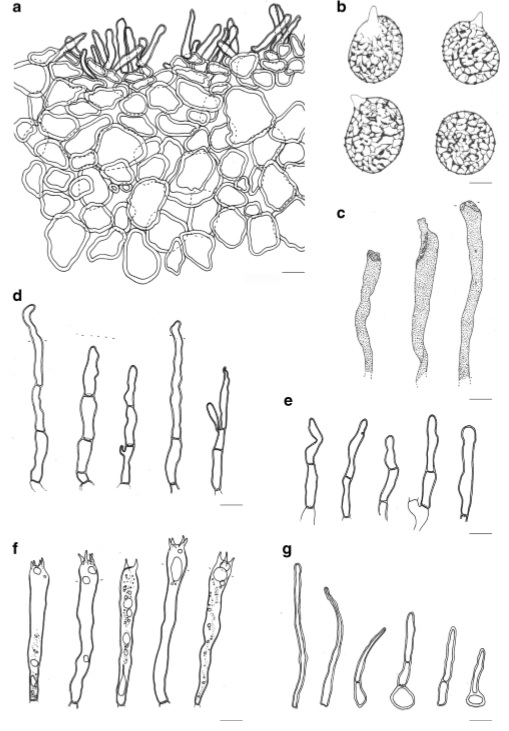Lactifluus armeniacus De Crop & Verbeken
MycoBank number: MB 815137 Facesoffungi number: FoF 02056
Etymology: Referring to the apricot-coloured basidiocarps.
Holotype: MFLU E. De Crop 14 –501
Pileus 69–72 mm diam., planoconvex with central depression to slightly infundibuliform; margin sometimes slightly striate, sometimes concentrically wrinkled; edge rather irregular, sometimes crenulate or locally undulate; surface chamois leather-like, locally wrinkled but smooth in the centre, pruinose, brigh to range (as5B5/6, but more yellow), unicolourous. Lamellae adnate with decurrent tooth to subdecurrent, distant (2L+1l/cm–4L+3l/cm), bright orange to yellow (4A3to 4/5A4), very broad, rather thick and brittle, slightly intervenose; edge entire and concolourous. Stipe 27– 28×11–18 mm, cylindrical to slightly tapering downwards, sometimes curved, centrally attached to pileus; surface very soft, pruinose and finely striate, concolourous with pileus (bright orange 5B5/6 with a more yellowish tinge). Context solid and quite firm, white, unchanging; taste sweet, mild; smell not distinctive. Latex abundant, white, unchanging; taste sweet. Basidiospores broadly ellipsoid, sometimes subglobose, sometimes ellipsoid, 6.4–7.7–9×5.1–6.2–6.7μm (n=20, Q=1.11–1.24–1.41); ornamentation amyloid, forming an almost complete reticulum, composed of very low warts connected by fine ridges, up to 0.2μm high; plage inamyloid. Basidia 4-spored, sometimes 2-spored, 59–71×8–9μm, cylindric to subclavate, with refringent to slightly thickened walls; content guttate to granular. Pleurolamprocystidia abundant, slightly emergent up to 17μm, cylindrical, septate, 50 – 80×4–8μm, with slightly thickened walls (<1μm). Pleuropseudocystidia very scarce, 7–9 μm, cylindrical, mostly collapsed at apex; content granular. Lamellae-edge sterile; completely composed of cheilolamprocystidia which are 41– 45×4–7 μm, cylindrical, septate, thick-walled. Hymenophoral trama cellular, with abundant lactifers and sphaerocytes. Pileipellis a lampropalisade; elements of the suprapellis 28–64×3–5μm, cylindrical, obtuse, thickwalled; subpellis 132–174μm thick, sphaerical cells 9– 22μm diam., with thickened wall. Stipitipellis hymeniderm; elements of the suprapellis 15–26×5–11μm, cylindrical to clavate, sometimes with strong congophilous content, thickwalled.
Material examined: THAILAND, Chiang Mai Province, Mae Taeng district, Baan Tapa (22 km marker along road 1095), N19°7′45″ E98°46′1″, alt. 766.8 m, on soil in mixed forest, with Dipterocarpus sp., Castanopsis sp., Lithocarpus sp. and Quercus sp., 31 July 2014, E. De Crop 14–501 (holotype in MFLU, isotype in GENT).



